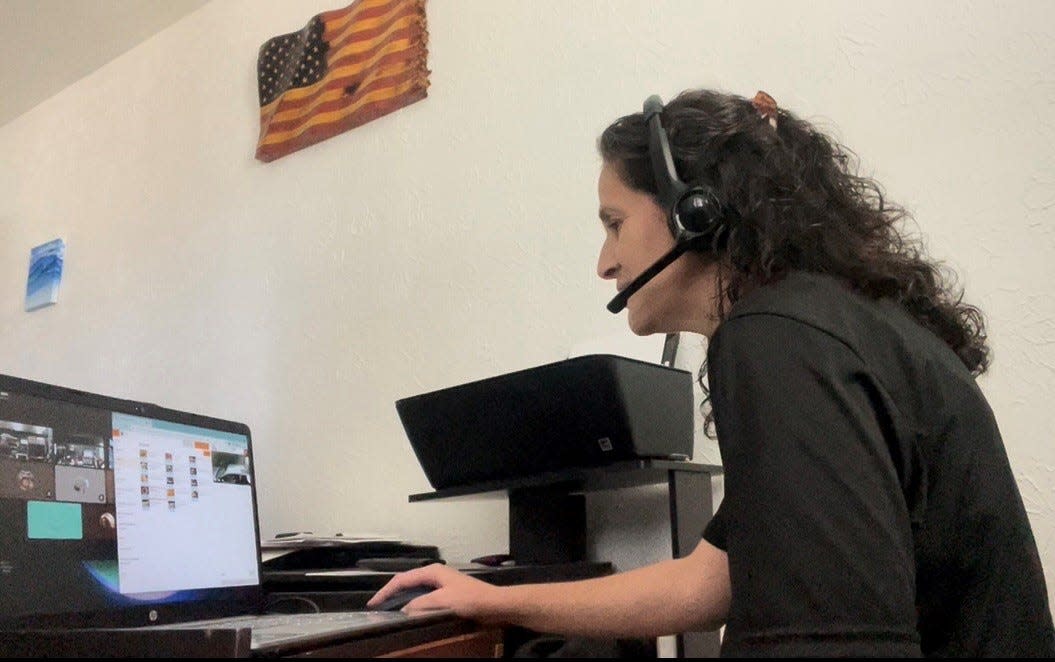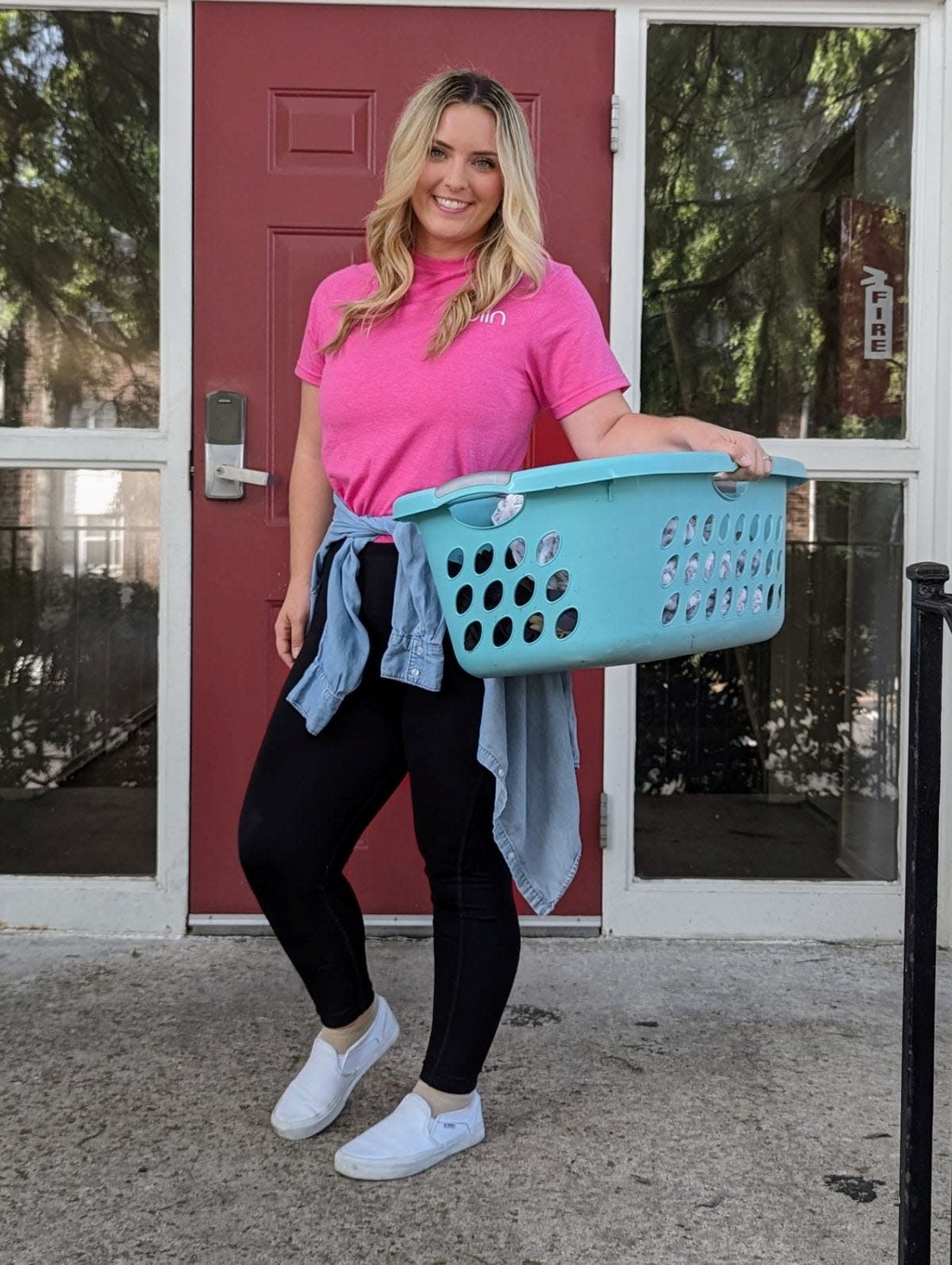Work from home as a drive-thru employee? How remote blue-collar jobs are catching on
Early last year, when Tabatha Curtis left her server job at Cracker Barrel to care for a daughter with health issues, her prospects for finding a position that would allow her to work from home seemed bleak.
There were plenty of remote job postings – for secretaries, tax preparers and customer service roles at communications and insurance companies.
“But I didn’t have the experience they were looking for,” says Curtis, who is 46 and lives in Killeen, Texas.
Then she saw an Indeed ad for a remote restaurant order taker and wondered, “How in the world is that going to work?”
Now she’s taking drive-thru orders for a fast-food chain called Baby Jack’s in Memphis, Tennessee, 600 miles away. “It’s right up my alley,” she says. “You’re sitting at home” in a T-shirt and sweats as a parade of drivers pop up on your laptop screen.
During slow periods, “I can have conversations with my daughter,” she adds. Plus, “I don’t have to pay for gas.”
The tectonic work-from-home shift sparked by the pandemic wasn’t confined to professional service workers, such as accountants, marketing specialists and human resources employees.
A smaller share of lower-paid service workers is also toiling remotely, including front desk receptionists, fast-food employees, laundry workers and tow truck dispatchers. The shift was triggered largely by the pandemic’s social distancing constraints and labor shortages, says Julia Pollak, chief economist of the job site ZipRecruiter.
And it’s made possible by videoconferencing software such as Zoom and other programs that connect workers to customers across the state or country, almost making them feel like they’re in the same room.
What is the labor force participation rate?
The newfound ability of lower-wage, blue-collar employees to work from home is one reason the share of adults working or looking for jobs hovered at 62.6% in June, up from 62.2% a year ago, though still below the 63.3% pre-pandemic level, Pollak says. Women age 25 to 54, including many with kids, have especially benefited, with their participation rate hitting a record 77.8% last month.
“Employers experience a large boost in job applications when they convert positions into remote roles,” she says.
A larger labor supply can curtail pay increases and inflation, giving the Federal Reserve another reason to halt its interest rate increases after an anticipated hike this week.
How many workers want remote work?
Overall, about 20% of active job seekers are looking only for remote work, Pollak says. And work-from-home setups reduce the number of employees who quit each year by 35%, according to Pollak and Nicholas Bloom, a Stanford University economics professor.
White-collar employees – who represent about 40% of total payrolls – still telework in far greater numbers than their blue-collar counterparts. Thirty-five percent of employees with jobs that can be done remotely (chiefly professionals and office staff) are working from home exclusively and 41% have a hybrid schedule, according to Pew Research Center. That's down from the pandemic's peak, but up from the 7% who worked from home all the time before the pandemic.
Yet blue-collar industries such as restaurants and retail may have the most to gain since they’ve been plagued by the most severe labor crunches, Pollak says.
Nearly 14% of employees in the bottom fourth of wage earners worked at home on an average day last year, below the 15.4% peak in 2021 but above the 9.5% mark in 2019, according to Labor Department figures released last month. That group worked remotely an average of 5.4 hours a day, compared to 2.6 hours in 2019.
By contrast, 56% of workers in the top fourth of earners worked remotely on a typical day last year.
Not 'smelling like a French fry'
Baby Jack’s, the Memphis restaurant chain that employs Curtis, decided to try remote drive-thru workers in January 2020, just before the pandemic began, as it struggled to find employees for its three locations, says Will Clem, owner of the barbeque chain. The health crisis intensified the need for a remote work option because labor shortages dramatically worsened even as customer demand at drive-thrus soared, he says.
After Clem ran online ads for remote drive-thru workers, applications swelled from one or two per opening to hundreds, he says.
Americans are working fewer hours: Hours have dropped since COVID. Here's why.
“Do you want to do the same job but not have to put on a uniform (or commute) and not come home smelling like a French fry?” he asks. Plus, “Customers would have no idea I’m not in the restaurant,” though the service now includes a video so employees and drive-thru patrons can see each other.
Clem created a sister company, called Bite Ninja, which employs about 200 remote gig workers who serve Baby Jack’s as well as a dozen fast-food chains in five other states – New York, Massachusetts, Rhode Island, Oklahoma and California.
Bite Ninja employees can grab two-hour shifts from home, with their ranks waxing during the lunch rush and waning by midafternoon. A new feature lets remote workers toggle among a chain’s various locations. During lulls, three workers could handle nine or 10 restaurants from their homes, shifting among the outlets with the click of a mouse. Some eateries also allow remote gig workers to serve customers at kiosks inside the restaurants as well.
The streamlined staff, along with lower average wages of about $10 an hour for remote employees, have reduced labor costs.
The work-from-home option, meanwhile, has created new job opportunities for stay-at-home mothers, disabled people, rural areas with few restaurants, and college students who can snag a two-hour shift between classes, Clem says.
While her daughter was ill last year, Curtis, the Baby Jack’s gig worker in Texas, was putting in 12-hour days, six days a week. Now that her daughter is better, Curtis has returned to working part time at Cracker Barrell and a few hours, several nights a week for Bite Ninja.

She says she loves helping customers and the gig often feels more like a sort of video game than a job.
“Many people work during the day, come home, sit down and turn on the TV,” Curtis says. “I sit down and turn on the computer.”
Can you get remote jobs without a degree?
Drive-thrus aren't the only blue-collar jobs going remote.
Some call center workers were already telecommuting before the pandemic but their ranks have swelled. Fourteen percent of ZipRecruiter job postings for call center reps were remote this month, up from 6% before the pandemic, though below the 39% peak in August 2021.
Remote job ads similarly grew from 2.7% to 6.8% for various kinds of dispatchers and from 1.6% to 3.9% for receptionists, ZipRecruiter figures show. Postings even rose from 0.5% to 5.2% for auto body jobs and 1.2% to 30% in pet care. Those likely represent back-office positions such as receptionists, schedulers and HR associates, Pollak says.
Initially, “employers didn’t trust” that low-paid workers would be productive at home but that concern dissipated quickly, Pollok says.
In March 2020, Extra Space Storage of Salt Lake City moved most of its roughly 200 call-center employees to remote positions due to the pandemic. It has kept the setup because it attracts significantly more job candidates and allows the firm to hire reps in other states, says company spokeswoman McKall Morris. Performance metrics reveal no drop-off in productivity, she says.
In 2018, Mort Fertel and his teenage son, Nachson, launched a laundry service in Baltimore, now called Poplin, that was modeled after Uber and let gig workers use their own washers and dryers to do other people’s laundry. Customers leave their dirty clothes outside their door, Poplin’s laundry “pros” pick them up; wash, dry and fold them; and return the bundle to the doorstep.
The impetus was simple: “The chore we hate the most is laundry,” Fertel says.
But the pandemic turbocharged the service by leading millions of workers to seek remote jobs and millions of consumers to question how they spend their time.
“People were asking, ‘What is the meaning of life?’” he says. “’Do I really want to spend three hours a week doing laundry?’”
In 2021, the company expanded to 500 U.S. markets, and Poplin’s roughly 100,000 laundry pros serve more than 1 million customers.
The service charges a dollar per pound of laundry, with the average job costing $42. Some pros rake in more than $100,000 a year.
Leah Sage, of St. Louis, began working for Poplin after she was laid off from her day care center job early in the pandemic. She wanted to work from home to spend time with her newborn son, who had been in intensive care for three weeks.
The health crisis, she says, “did show me how important it is for my son to have as much of my time as I can give him.”
Initially, Sage logged 20 to 25 hours and brought in about $400 each week, more than she earned in two weeks working full-time at the day care center. Recently, she got a part-time job at a local gym and has trimmed her Poplin schedule to about 10 hours a week, mostly in the evenings.

But she has no plans to give up the gig.
Noting her income supplements her husband’s warehouse pay, she says that if she hadn’t come across the Poplin ad on Facebook, “I don’t know what we would have done.”
This article originally appeared on USA TODAY: Work from home jobs becoming popular among blue-collar employees







